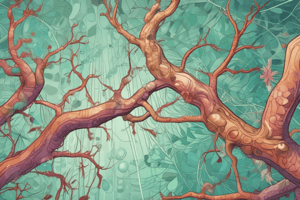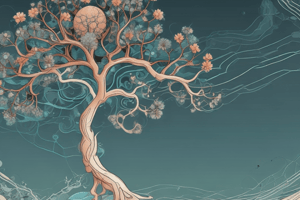Podcast
Questions and Answers
What is the fundamental unit of life according to cell theory?
What is the fundamental unit of life according to cell theory?
- Group of cells
- Cell (correct)
- Atom
- Molecule
Which branch of biology focuses on the study of heredity?
Which branch of biology focuses on the study of heredity?
- Zoology
- Ecology
- Botany
- Genetics (correct)
In the context of ecosystems, what role do decomposers play?
In the context of ecosystems, what role do decomposers play?
- Aid in the growth of producers
- Break down organic material (correct)
- Create energy through photosynthesis
- Producers' primary food source
Which of the following best describes the process of natural selection?
Which of the following best describes the process of natural selection?
Which organelle is primarily responsible for energy production in cells?
Which organelle is primarily responsible for energy production in cells?
What is the structure of DNA characterized by?
What is the structure of DNA characterized by?
What type of relationship do primary consumers have in an ecosystem?
What type of relationship do primary consumers have in an ecosystem?
Which physiological system is primarily involved in gas exchange?
Which physiological system is primarily involved in gas exchange?
Study Notes
Overview of Biology
- Definition: Biology is the scientific study of life and living organisms.
- Branches:
- Botany: Study of plants.
- Zoology: Study of animals.
- Microbiology: Study of microorganisms.
- Ecology: Study of interactions between organisms and their environment.
- Genetics: Study of heredity and variation in organisms.
- Molecular Biology: Study of biological molecules and their interactions.
Cell Biology
- Cell Theory:
- All living organisms are composed of cells.
- The cell is the basic unit of life.
- All cells arise from pre-existing cells.
- Types of Cells:
- Prokaryotic: Simple, no nucleus (e.g., bacteria).
- Eukaryotic: Complex, with a nucleus (e.g., plants, animals).
- Cell Organelles:
- Nucleus: Control center, contains DNA.
- Mitochondria: Powerhouse, produces energy (ATP).
- Ribosomes: Protein synthesis.
- Chloroplasts: Photosynthesis (in plants).
- Endoplasmic Reticulum: Protein and lipid synthesis.
Genetics
- DNA Structure:
- Double helix, composed of nucleotides (A, T, C, G).
- Gene Expression:
- Transcription: DNA to mRNA.
- Translation: mRNA to protein.
- Mendelian Genetics:
- Laws of inheritance (dominant and recessive traits).
- Punnett Squares: Predict genetic outcomes.
Evolution
- Natural Selection: Mechanism of evolution proposed by Charles Darwin.
- Organisms with favorable traits tend to survive and reproduce.
- Speciation: Formation of new species through evolutionary processes.
- Evidence for Evolution:
- Fossil records.
- Comparative anatomy.
- Molecular biology.
Ecology
- Ecosystems: Biological communities interacting with their environment.
- Trophic Levels:
- Producers: Autotrophs (e.g., plants).
- Consumers: Heterotrophs (primary, secondary, tertiary).
- Decomposers: Break down organic material.
- Biomes: Large geographic biotic communities (e.g., tundra, rainforest).
- Biodiversity: Variety of life in an ecosystem; important for resilience and adaptability.
Physiology
- Human Body Systems:
- Circulatory: Transports blood and nutrients.
- Respiratory: Gas exchange.
- Digestive: Breaks down food for energy.
- Nervous: Controls body responses.
- Homeostasis: Maintenance of stable internal conditions (e.g., temperature, pH).
Biotechnology
- Applications:
- Genetic engineering (e.g., CRISPR).
- Pharmaceuticals (e.g., insulin production).
- Agricultural improvements (e.g., GMOs).
- Ethical Considerations: Impact on health, environment, and society.
Conclusion
- Biology is foundational to understanding life processes, interactions among organisms, and the evolution of species.
- Continued research expands knowledge and applications in health, ecology, and biotechnology.
Overview of Biology
- Biology is the scientific study focusing on life and living organisms.
- Key branches include:
- Botany: Investigates plant life and its processes.
- Zoology: Examines animal species and their characteristics.
- Microbiology: Studies microscopic organisms, including bacteria and viruses.
- Ecology: Analyzes interactions between organisms and their environments.
- Genetics: Explores heredity, gene variation, and inheritance patterns.
- Molecular Biology: Investigates biological molecules and their functions.
Cell Biology
- The Cell Theory states that:
- All living organisms consist of one or more cells.
- The cell is the fundamental unit of life.
- New cells arise from the division of pre-existing cells.
- Types of cells include:
- Prokaryotic: Simple cells without a nucleus, such as bacteria.
- Eukaryotic: Complex cells with a nucleus, found in plants and animals.
- Primary cell organelles and their functions:
- Nucleus: Houses DNA; acts as the control center.
- Mitochondria: Generates cellular energy in the form of ATP.
- Ribosomes: Sites for protein synthesis.
- Chloroplasts: Enable photosynthesis in plant cells.
- Endoplasmic Reticulum: Involved in protein and lipid synthesis.
Genetics
- DNA is structured as a double helix and made up of nucleotides represented by A, T, C, and G.
- Gene expression involves:
- Transcription: Conversion of DNA into messenger RNA (mRNA).
- Translation: Process of synthesizing proteins from mRNA.
- Mendelian genetics outlines the principles of inheritance, including dominant and recessive traits.
- Punnett Squares are tools used to predict genetic combinations and outcomes.
Evolution
- Natural selection, as proposed by Charles Darwin, is a key mechanism of evolution.
- Organisms with advantageous traits are more likely to survive and reproduce.
- Speciation refers to the development of new species over time through evolutionary mechanisms.
- Evidence supporting evolution includes:
- Fossil records that document changes over geological time.
- Comparative anatomy highlighting similarities among different species.
- Molecular biology, which uncovers genetic relatedness among organisms.
Ecology
- Ecosystems comprise biological communities and their physical environments.
- Trophic levels include:
- Producers: Autotrophs like plants that create energy through photosynthesis.
- Consumers: Heterotrophs that rely on other organisms for food (primary, secondary, tertiary).
- Decomposers: Organisms that break down dead organic matter.
- Biomes represent distinct geographic areas characterized by specific climates and ecosystems (e.g., tundra, rainforest).
- Biodiversity is the variety of life forms within an ecosystem, crucial for ecological stability and resilience.
Physiology
- The human body consists of various systems, each with unique functions, such as:
- Circulatory System: Responsible for transporting blood, oxygen, and nutrients throughout the body.
- Respiratory System: Facilitates gas exchange, primarily oxygen and carbon dioxide.
- Digestive System: Breaks down food to obtain energy and nutrients.
- Nervous System: Regulates body activities and responses to external stimuli.
- Homeostasis refers to the process of maintaining stable internal conditions, including temperature and pH levels.
Biotechnology
- Applications of biotechnology include:
- Genetic Engineering: Techniques like CRISPR for modifying genetic material.
- Pharmaceutical Development: Production of life-saving drugs such as insulin.
- Agricultural Enhancements: Genetically modified organisms (GMOs) to improve crop yields.
- Ethical considerations address the potential impacts of biotechnological advances on health, the environment, and society.
Conclusion
- Biology serves as the cornerstone for understanding life processes, organism interactions, and species evolution.
- Ongoing research in biology enhances knowledge and drives innovations in health, ecology, and biotechnology.
Studying That Suits You
Use AI to generate personalized quizzes and flashcards to suit your learning preferences.
Description
This quiz covers the fundamental concepts of biology, including the various branches such as botany, zoology, and ecology. It also delves into cell biology, discussing cell theory, types of cells, and key organelles. Test your knowledge on the scientific study of life and the structures that sustain it.




